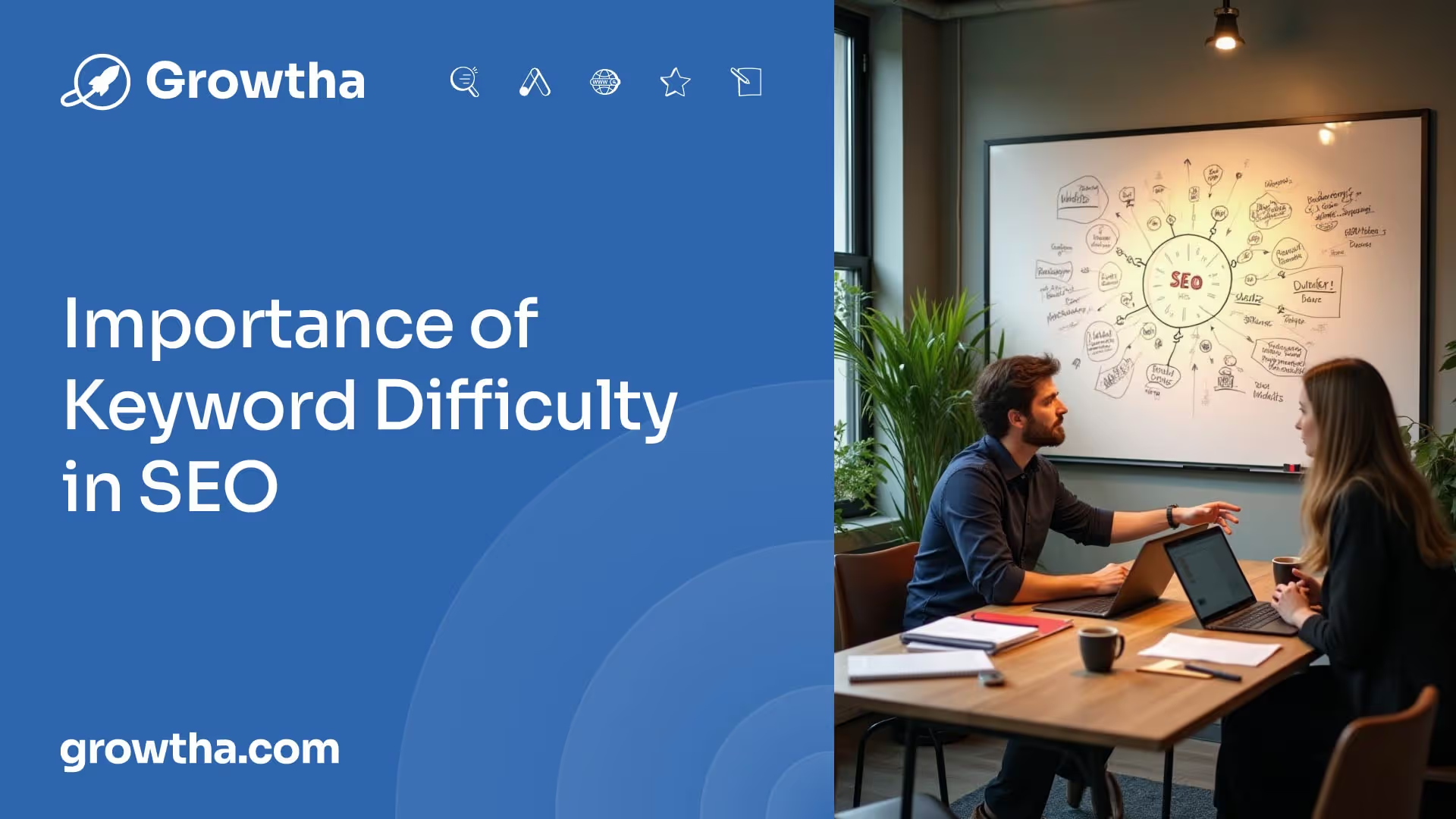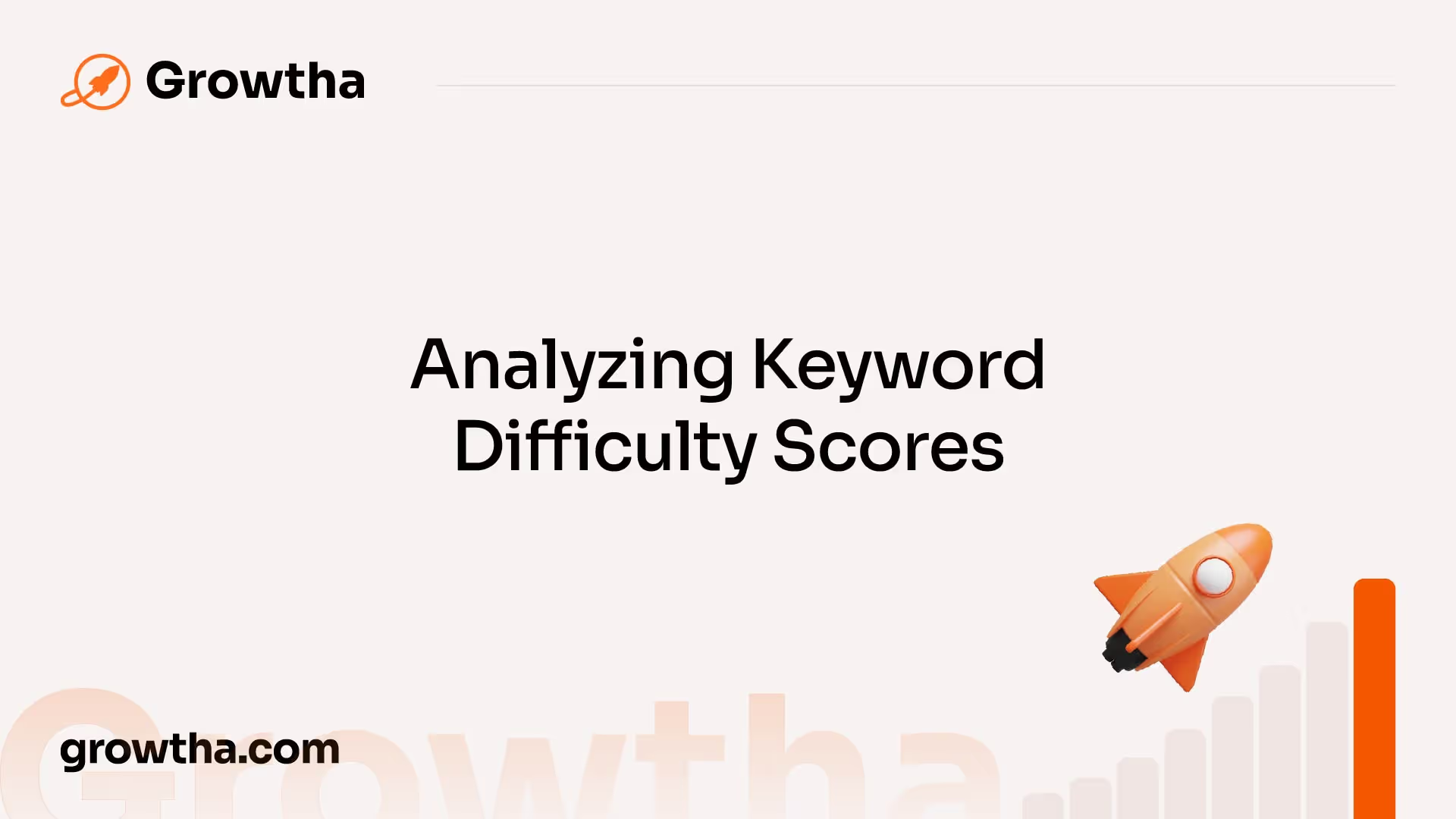Keyword Difficulty: How to Estimate Your Chances to Rank
Keyword research tools assign difficulty scores to keywords, which provide insights into the level of effort required to rank well.


Keyword Difficulty: How to Estimate Your Chances to Rank
Understanding Keyword Difficulty

To effectively navigate the world of search engine optimization (SEO), it is crucial to understand the concept of keyword difficulty. This section will provide a clear understanding of what keyword difficulty entails and the factors that influence it.
Definition of Keyword Difficulty
Keyword difficulty, also referred to as "SEO difficulty" or "keyword competition," is an estimate of how challenging it is to rank in the organic search results for a specific term. It takes into account various factors, such as domain authority, page authority, and content quality, to determine the level of competition for a particular keyword [1].
Keyword research tools assign difficulty scores to keywords, which provide insights into the level of effort required to rank well. These scores are typically presented as numerical values or a scale (e.g., low, medium, high, or 0-100) to indicate the relative level of difficulty in ranking for a specific keyword [2].
Factors Influencing Keyword Difficulty
Several factors influence keyword difficulty, making it essential to consider various aspects when assessing the competitiveness of a keyword. While different keyword research tools may provide varying difficulty scores for the same keyword, identifying the most accurate tool for your analysis is crucial.
Here are some key factors that contribute to keyword difficulty:
- Domain Authority: The authority of a website's domain, as measured by metrics like backlinks, site age, and overall reputation, plays a significant role in keyword difficulty. Websites with higher domain authority are typically more competitive.
- Page Authority: Similar to domain authority, the authority of a specific page on a website, determined by factors such as backlinks and content quality, affects keyword difficulty. Pages with higher authority are more likely to rank well.
- Content Quality: The quality and relevance of the content on a webpage are crucial for ranking. Well-optimized, comprehensive, and engaging content is more likely to rank higher in search results.
- Backlinks: The number and quality of backlinks to a webpage impact keyword difficulty. Backlinks from authoritative and relevant websites signal to search engines that the content is trustworthy and valuable.
- On-Page Optimization: Proper on-page optimization, including keyword usage in titles, headings, meta tags, and content, can positively influence keyword difficulty.
Different keyword research tools consider various factors when assigning difficulty scores. For example, Semrush's keyword difficulty score goes beyond authority metrics and also analyzes content quality, backlinks, and on-page optimization, providing a more comprehensive assessment [1].
Understanding the factors that influence keyword difficulty is crucial for developing an effective SEO strategy. By considering these factors, you can make informed decisions about which keywords to target and tailor your approach accordingly.
Importance of Keyword Difficulty in SEO

When it comes to search engine optimization (SEO), understanding the concept of keyword difficulty is crucial for developing an effective strategy. Keyword difficulty, also known as SEO difficulty or keyword competition, refers to the estimate of how difficult it is to rank in Google's organic search results for a specific term. This estimation takes into account factors such as domain authority, page authority, and content quality [1].
Impact on Ranking Strategy
Keyword difficulty plays a significant role in shaping your ranking strategy. Higher rankings in organic search results tend to generate more clicks, which can lead to increased website conversions and better business results. By assessing keyword difficulty, you can identify which keywords are more competitive and require additional efforts to rank well.
A comprehensive understanding of keyword difficulty allows you to prioritize your resources and focus on the keywords that offer the best balance between search volume and competition. SEO teams often aim for moderate-competition or low-competition keywords with good search volumes, as these present valuable opportunities for optimization.
Role in Content Planning
Keyword difficulty also plays a vital role in content planning. By analyzing keyword difficulty scores, you can identify keywords that align with your content goals and target audience. This insight helps you tailor your content strategy to focus on keywords that offer a realistic chance of ranking well.
SEO teams use keyword difficulty scores to prioritize content opportunities based on demand and competition. By focusing on keywords with lower difficulty scores and adequate search volumes, known as "low-hanging fruit," you can drive traffic and establish authority in a specific topic area over time [2]. Incorporating these keywords into your content planning ensures that you are targeting the right audience and increasing the likelihood of organic traffic and engagement.
Understanding the relationship between keyword difficulty and search volume is crucial for effective targeting. High search volume often correlates with increased competition, elevating the keyword's difficulty score. By comprehending the volume and keyword difficulty, you can identify which terms are worth targeting and tailor your content accordingly [5].
In summary, keyword difficulty is an essential metric in SEO. It impacts your ranking strategy by helping you identify competitive keywords and prioritize resources effectively. Additionally, keyword difficulty plays a vital role in content planning by guiding you towards keywords that have a good balance of search volume and competition. By considering keyword difficulty, you can optimize your SEO efforts and improve your chances of ranking well in organic search results.
Analyzing Keyword Difficulty Scores

When it comes to keyword research for SEO purposes, understanding the difficulty of ranking for specific keywords is crucial. Analyzing keyword difficulty scores provides valuable insights into the level of competition and helps determine the feasibility of targeting certain keywords. In this section, we will explore two aspects of analyzing keyword difficulty scores: interpreting percentage scores and utilizing different tools.
Interpreting Percentage Scores
Keyword difficulty (KD%) is commonly expressed as a percentage, with higher percentage scores indicating higher difficulty in ranking for a particular keyword. For example, a keyword with a 100% difficulty score would be extremely challenging to rank for, while a keyword with a 0% difficulty score would be relatively easier to rank for.
It's important to note that different keyword research tools may have variations in the way they calculate keyword difficulty scores. Therefore, it is crucial to understand the methodology and scoring system used by the tool you are using. For instance, in Semrush, a popular SEO tool, keyword difficulty is expressed as a percentage, with 100% being the highest difficulty level [3].
While there isn't a universally defined threshold for what constitutes a "good" or "bad" keyword difficulty score, it's generally understood that lower scores indicate relatively easier keywords to rank for. However, the interpretation of keyword difficulty scores may vary depending on your specific SEO strategy and the competitive landscape in your niche. As a general guideline, keyword difficulty scores can be categorized as follows:

Figures courtesy of seoClarity
Utilizing Different Tools
Various keyword research tools provide keyword difficulty scores, and it's essential to utilize multiple tools to gain a comprehensive understanding of the difficulty level. Different tools may use different methodologies and data sources to calculate keyword difficulty, leading to variations in scores for the same keyword across tools. Some popular tools include Semrush, Moz, Ahrefs, and Ubersuggest.
When analyzing keyword difficulty, it's recommended to compare scores from multiple tools and identify the most accurate and reliable tool for your specific needs. Consider factors such as the size and quality of the tool's database, the relevance of the data sources, and the track record of the tool in providing accurate keyword data.
By utilizing different keyword research tools, you can gain a more comprehensive understanding of the keyword difficulty landscape and make informed decisions when it comes to keyword targeting in your SEO strategy.
Analyzing keyword difficulty scores is a vital step in keyword research. It helps you identify the level of competition and determine which keywords are worth targeting. By interpreting the percentage scores and utilizing different tools, you can effectively assess the keyword difficulty and optimize your SEO efforts accordingly.
Strategies for Targeting Keywords

When it comes to targeting keywords for your SEO strategy, it's important to consider the level of keyword difficulty. Keyword difficulty refers to the level of competition you can expect to face when trying to rank for a particular keyword. Understanding and strategizing around different keyword difficulty levels can help you optimize your SEO efforts effectively. Let's explore the strategies for targeting high difficulty, moderate difficulty, and low difficulty keywords.
High Difficulty Keywords
High difficulty keywords, often indicated by a keyword difficulty score above 70 [4].
To tackle high difficulty keywords, consider the following strategies:
- Create high-quality, comprehensive content that provides value and stands out from the competition.
- Focus on building strong inbound links from reputable websites to boost your website's authority.
- Utilize long-tail keywords that are related to high difficulty keywords to capture more targeted traffic.
- Stay updated with the latest SEO techniques and trends to stay ahead of the competition.
Moderate Difficulty Keywords
Moderate difficulty keywords fall within the range of 31 to 70 on the keyword difficulty scale. These keywords have a moderate level of competition and can be a good target for your SEO efforts.
To optimize your approach for moderate difficulty keywords, consider the following strategies:
- Conduct thorough keyword research to identify relevant and attainable moderate difficulty keywords.
- Create high-quality content that addresses the search intent of your target audience.
- Optimize on-page elements, such as title tags, meta descriptions, and headings, with the targeted keywords.
- Build a strong internal linking structure to enhance the visibility and crawlability of your content.
Low Difficulty Keywords
Low difficulty keywords typically have a keyword difficulty score below 30 [2]. These keywords have relatively low competition, making it easier to rank for them.
To make the most of low difficulty keywords, consider the following strategies:
- Identify long-tail keywords that are specific and relevant to your target audience.
- Optimize your content with the low difficulty keywords, ensuring they are naturally incorporated.
- Create valuable and informative content that addresses the needs and interests of your target audience.
- Focus on building a strong internal linking structure to improve the overall visibility of your website.
By implementing targeted strategies based on the level of keyword difficulty, you can optimize your SEO efforts and improve your chances of ranking well in search engine results. Remember to continually monitor and analyze the performance of your targeted keywords to refine your strategy and achieve optimal results.
Enhancing SEO with Keyword Difficulty

In the realm of SEO, understanding and leveraging keyword difficulty can significantly impact the success of your digital marketing efforts. Two effective strategies for enhancing SEO with keyword difficulty are leveraging long-tail keywords and conducting competitor analysis for valuable insights.
Leveraging Long-Tail Keywords
Long-tail keywords, as explained by Semrush, are keyword phrases that consist of three or more words. These longer word counts often result in lower difficulty scores, as they typically have lower competition levels. Targeting long-tail keywords can be a strategic approach to boost your SEO efforts.
Long-tail keywords with low difficulty scores can be excellent targets, as they often correlate with high engagement and conversion rates, as stated by Semrush. By focusing on these specific, niche phrases, you can attract more qualified traffic to your website.
When using long-tail keywords, it's essential to ensure they align with your content and target audience. By addressing specific needs or queries, you can capture the attention of users actively searching for information related to your industry or offerings. This targeted approach can lead to better engagement and higher conversion rates.
Competitor Analysis for Insights
Conducting competitor analysis is another valuable strategy for enhancing SEO with keyword difficulty. By examining the keywords and strategies used by your competitors, you can gain insights into their success and identify opportunities for improvement.
Analyzing competitor keywords allows you to identify keywords they are ranking for and understand their difficulty scores. This information, as highlighted by seoClarity, helps you prioritize content opportunities based on demand and competition.
By focusing on less difficult keywords with adequate search volume, often referred to as "low hanging fruit," you can drive traffic and establish authority in a specific topic area over time, as suggested by seoClarity. This approach enables you to gradually build your online presence and target keywords that align with your business objectives.
Competitor analysis also allows you to identify gaps in their keyword strategies. By finding keywords that your competitors may have overlooked, you can create content that fills those gaps and attract organic traffic that they may be missing.
By leveraging long-tail keywords and conducting competitor analysis, you can enhance your SEO efforts and increase your chances of ranking higher in search engine results. These strategies enable you to target specific, less competitive keywords and optimize your content to meet the needs and expectations of your target audience.
Practical Applications of Keyword Difficulty
Keywords play a crucial role in SEO campaigns, and understanding the meaning of keyword difficulty scores can greatly optimize these campaigns. By analyzing the difficulty scores, SEO professionals can make informed decisions to maximize organic traffic and optimize their overall SEO strategy.
SEO Campaign Optimization
Keyword difficulty scores are pivotal in shaping a successful SEO campaign [5]. When conducting keyword research, SEO teams prioritize content opportunities based on demand and competition. By focusing on keywords with moderate or low difficulty scores and adequate search volume, known as "low hanging fruit," they can drive traffic and establish authority in specific topic areas over time [2].
By targeting keywords with lower difficulty scores, SEO professionals can achieve quicker wins and build momentum in their campaigns. These keywords may have less competition, making it easier to rank higher in search engine results. It's important to note that while the search volumes for these keywords may be lower, the cumulative effect of targeting multiple low difficulty keywords can result in significant organic traffic growth.
Maximizing Organic Traffic
Keyword difficulty is an essential metric to consider when deciding which keywords to target. Ideally, SEO professionals aim to target keywords with moderate or low competition and good search volumes. This strategic approach allows them to strike a balance between achievable rankings and attracting a substantial amount of organic traffic.
By understanding the relationship between search volume and keyword difficulty, SEO professionals can identify which terms are worth targeting. High search volume often correlates with increased competition, resulting in higher keyword difficulty scores. By selecting keywords with a favorable balance between search volume and difficulty, SEO professionals can maximize organic traffic while optimizing their resources.
In conclusion, keyword difficulty scores have practical applications in SEO campaigns. By leveraging these scores, SEO professionals can optimize their campaigns, target keywords that offer the best balance between competition and search volume, and ultimately drive more organic traffic to their websites.
References
[1]: https://backlinko.com/hub/seo/keyword-difficulty
[2]: https://www.seoclarity.net/blog/calculate-keyword-difficulty
[3]: https://www.semrush.com/blog/keyword-difficulty/
[4]: https://www.spyfu.com/blog/what-is-keyword-difficulty/
[5]: https://agencyanalytics.com/kpi-definitions/keyword-difficulty-score







